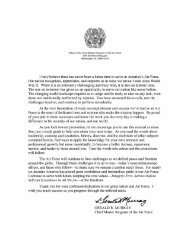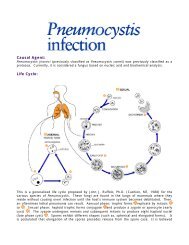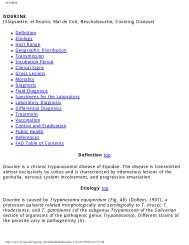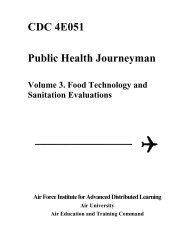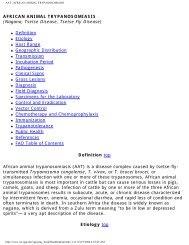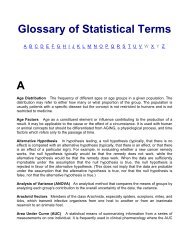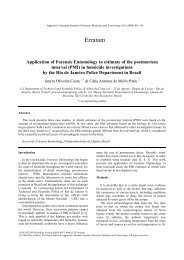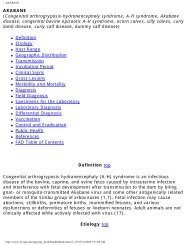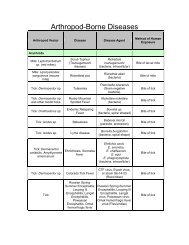Amebiasis Handout Entamoeba histolytica E. histolytica vs. E. dispar
Amebiasis Handout Entamoeba histolytica E. histolytica vs. E. dispar
Amebiasis Handout Entamoeba histolytica E. histolytica vs. E. dispar
Create successful ePaper yourself
Turn your PDF publications into a flip-book with our unique Google optimized e-Paper software.
Non-Invasive and Invasive Isolates of <strong>Entamoeba</strong> <strong>histolytica</strong><br />
CRITERIA NON-INVASIVE INVASIVE<br />
In Vitro Culture xenic axenic<br />
ConA Agglutination - +<br />
Complement Resistance - +<br />
Zymodemes (isoenzymes) I & III II<br />
Numerous Antigenic Differences<br />
(eg., GIAP Epitopes) 1-2 1-6<br />
Numerous DNA Sequence Differences<br />
(eg., rRNA)<br />
2.2% sequence diversity<br />
B133<br />
P145<br />
RFLP/DNA Probes<br />
cEH-NP1 cEH-P1<br />
Pathogenic and non-pathogenic isolates of <strong>Entamoeba</strong> <strong>histolytica</strong> exhibit many phenotypic differences. Some<br />
of the first noted differences were the in vitro growth characteristics, agglutination with concanavalin A, and<br />
resistance to complement. Pathogenic strains have the ability to grow in axenic cultures (without bacteria)<br />
whereas the non-pathogenic strains required bacteria for in vitro growth. The ConA agglutination and<br />
complement resistance imply that the outer surfaces of the pathogenic and non-pathogenic strains are<br />
different. Isoenzyme analysis revealed different zymodemes for the pathogenic and non-pathogenic strains.<br />
Similarly, numerous antigenic differences were noted between pathogenic and non-pathogenic isolates. A<br />
well-characterized epitope difference is in a surface protein referred to as galactose-inhibitable adherence<br />
protein (GIAP). GIAP (also called eh-lectin) is also implicated to be involved in the ConA agglutination and<br />
the resistance to complement. Analysis of DNA and sequencing of genes revealed genotypic differences<br />
between the pathogenic and non-pathogenic isolates. A striking variation is the 2.2% difference between the<br />
ribosomal RNA gene sequences of pathogenic and non-pathogenic isolates. Unlike some of the other<br />
differences, the rRNA cannot contribute to the pathogenesis. Furthermore, rRNA sequences of humans and<br />
mice differ by less than 2.2% indicating that the pathogenic and non-pathogenic strains are quite diverged.<br />
These differences led to the formation of a new species call E. <strong>dispar</strong>.<br />
POSSIBLE INVASION FACTORS<br />
• host factors (eg, immune response)?<br />
• parasite factors?<br />
♦ resistance to host response (eg,<br />
complement resistance)<br />
♦ adherence properties (eg, GIAP)<br />
♦ cytolytic properties (adherence +<br />
'amoebapore')<br />
♦ ability to breakdown tissues (eg,<br />
secreted proteases)<br />
4



